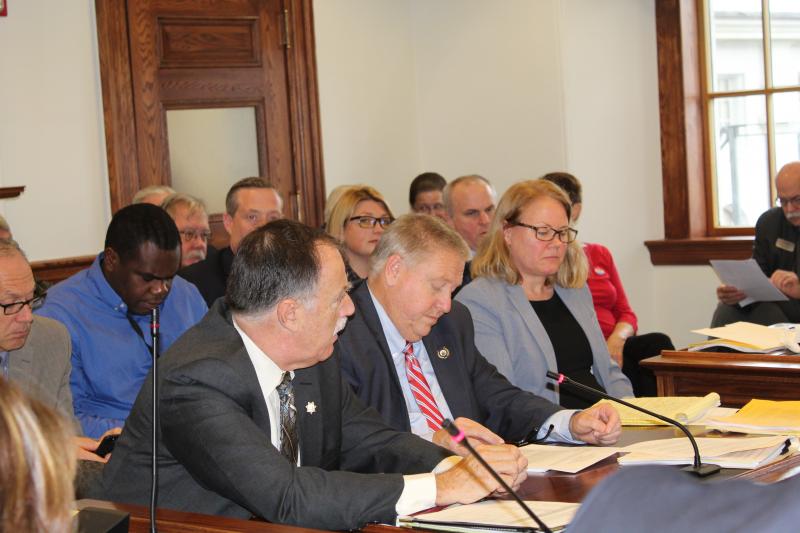Jail funding a go for emergency session
Two Bridges Regional Jail can expect more stable state funding levels from an amended bill that would set a permanent state share for county jails. The bill, LD 973, passed out of the Criminal Justice and Public Safety Committee to the full Legislature after several hearings and work sessions. The bill will go to the 2020 emergency session. If it passes the full legislature as amended, county jails would be guaranteed at least 20 percent of their budgets from state coffers.
The bill is sponsored by Rep. Charlotte Warren (D-Hallowell), the committee’s House chair. Warren presented amendments to the bill Dec. 10. After the unanimous ought to pass vote, Warren thanked all participants in the process. Those included jail administrators, sheriffs, county commissioners, mayors, Maine Municipal Association, the Department of Corrections, and people involved in community corrections services.
“We don't just need to fix the funding mechanism for county corrections in Maine, we need to address population size,” Warren said. “I am proud that today we coalesced on a bill that looks at where offenders should be held and supports programming aimed at decreasing recidivism.”
The new bill would change distribution from annual to quarterly. These funds are released after the jails report their bed count and budget, to ensure the funds go where needed most, Warren said. “This bill also requires that 25 percent of the funds go toward programming and services for inmates, many of which help inmates prepare for their transition out of jail. The final product is a bill that has broad support and will drive thorough change that will support our county corrections while saving taxpayers money.”
The sheriffs, who presented the draft legislation, did not get everything they wanted, but are hopeful the law will solve the biggest issues around jail funding, especially the amount of work involved to get supplemental funding; that process was time-consuming and rarely covered all the expenses involved, they said.
In the amended bill, the state accepts responsibility for a group of inmates called state-sanctioned, according to Lincoln County Sheriff Todd Brackett. “These are people that the state agrees it is their responsibility to keep off the streets, whether they are in Aroostook County or York County,” he said. “They are charged with, or have been convicted of, crimes like murder, and A, B, and C class offenses.” The legislation would have the state pay counties $50 per bed per night any time they arrest or hold a state-sanctioned inmate.
State-sanctioned status can also occur if the inmate is serving consecutive sentences that together exceed nine months; is being held on probation violations and was in Department of Corrections custody for the underlying offense; a court-ordered deadline has been exceeded for mental health evaluation and treatment; or is sentenced for contempt of court.
For fiscal year 2019-2020, the state must fund $18,442,104, or 20 percent, of total jail operation costs statewide. The quarterly payments depend on jails submitting monthly reports of their costs of operations to the Department of Corrections. Beginning in fiscal year 2022, the state must fund at least 20 percent of the prior year’s actual total jail costs, or $50 per day for all state-sanctioned inmates, whichever is greater. The funding will go to the jails based on the county where the crime allegedly took place, or to the sheriff or jail administrator to whom the inmate is committed.
The bill would let counties do a one-time adjustment of their property tax cap in 2021 to reflect the actual cost of funding the county’s jail. In some cases, the cap will rise; in others, it may go down, said Sagadahoc Sheriff Joel Merry. “The caps were set lower than what it actually costs to run the jails, in most cases. Year after year, the jails have had to go back to the state for supplemental funding, and sometimes it was granted, and sometimes not,” he said. He added that while the state is currently funding the jails at about 20 percent, for many years, it wasn’t. “In 2008, we were receiving less than 10 percent from the state,” he said. “We’re in a better place now, but it needs to be set so that future legislatures can’t change it.”
Brackett said Lincoln County’s cap could go down. That’s because the jail’s building costs are still fairly stable and both Lincoln and Sagadahoc counties are doing their best to keep local low-level offenders out of the jail system, while bringing in inmates from other counties to cover basic operating costs. With the state picking up the cost of state-sanctioned inmates, operating costs may fall, Brackett said. Whichever happens, the cap is then stabilized, and then – according to the legislation – can be reexamined every six years.
Certain things the sheriffs proposed, but that did not survive committee, were big ticket items, among them, health care costs and mental health and substance disorder treatment. Brackett said that when the sheriffs looked at those numbers, they couldn’t find a clear way to project them. Warren pointed that out in committee. The new system will force counties to keep better records to get paid, and the issue may be revisited. Merry said getting the bill on to the full legislature was important, and the difference between the $18 million and the $25 million it would have cost with health care could have kept the bill from passing into law. Both sheriffs believe the bill, as amended, will provide adequate jail funding and protection for county property taxpayers.
The jails will have to meet best practices and report and verify their costs. The bill mandates that by 2022, a stakeholders group including county jail administrators and sheriffs and the Department of Corrections will meet regularly to share best practices, and plan efficiencies. The group would be called the County Corrections Coordinating Council. Twenty-five percent of state funding must be spent on inmate programs and services; the CCCC will determine the makeup of those programs and services.
Brackett said there will be a huge difference between the defunct Board of Corrections and this new entity. “This will be a supportive group, mainly of county jail personnel and commissioners, and while the DOC will have a vote on anything we decide, so will all the other stakeholders,” he said. He described the process as collaborative, rather than top-down.
By April 1 every year, Maine County Commissioners Association and Maine Sheriffs Association will report to the Criminal Justice and Public Safety Committee on jail funding and operations.
Event Date
Address
United States
























